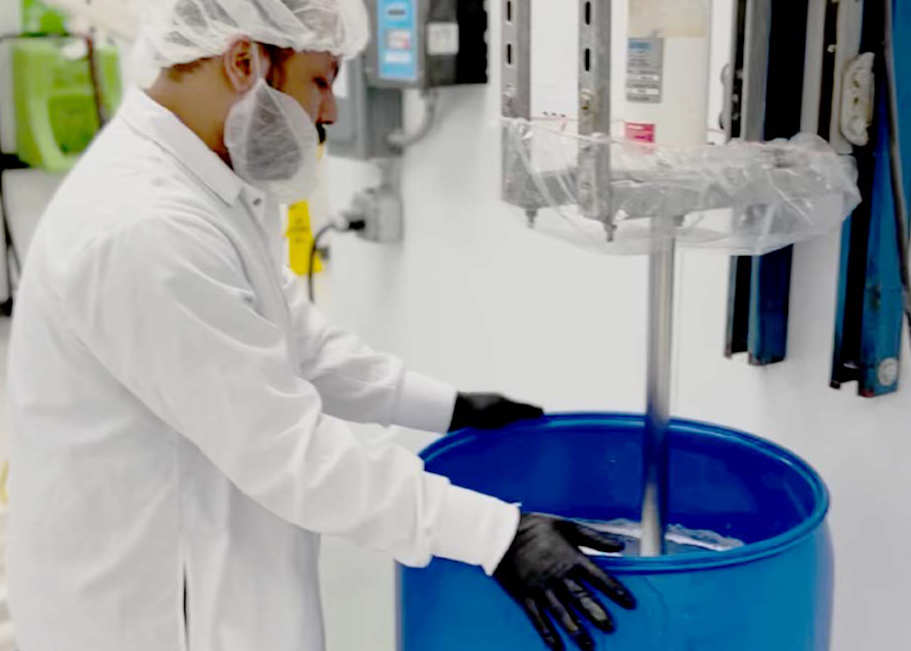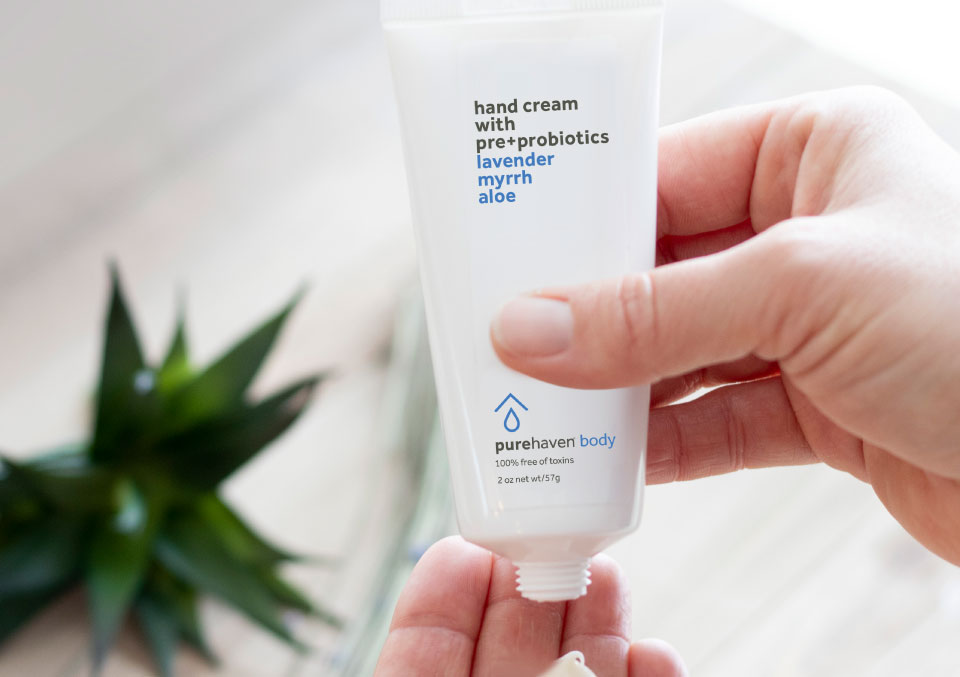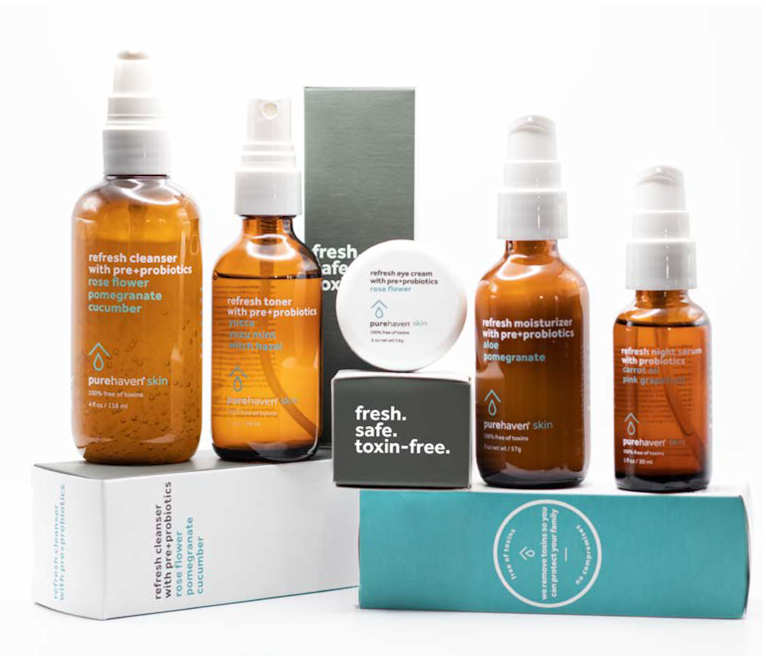welcome to Pure Haven
Meet Miranda Inglis, Chief Executive Officer.
Miranda lives in Ohio with her husband and two sons, who are her everyday reminder of why Pure Haven’s mission to educate and protect families is so important.
Miranda’s dedication to non toxic living is a result of a long personal struggle with infertility. She became passionate about clean ingredients and found Pure Haven while searching for safe products for her family.
A former engineer and operations, sales, and product development leader in the automotive industry, Miranda became a true “mom on a mission.” She went from creating her own safe formulations for her family at home to sharing Pure Haven’s important mission and products with others as an independent Consultant.
more +
In 2017, after three years building a successful Consultant business, Miranda joined the Pure Haven Corporate team, unleashing her zeal for helping others thrive in this life-changing business model. In October 2022, Miranda was appointed as Pure Haven’s Chief Executive Officer. Now, as our non tox CEO, Miranda is driving the company’s long-term growth with an unwavering commitment and dedication to the Pure Haven mission and our Customers’ and Consultants’ success in implementing and sharing this lifestyle so that others are able to avoid similar struggles.
To inquire about booking Miranda as a podcast guest speaker, please email podcastrequest@purehaven.com. Find her on Instagram @nontoxceo.
We are mission driven.

Our mission is to educate consumers about current health risks in personal care and home products and provide completely safe, effective, non toxic product alternatives, and in so doing, empower thousands of independent Consultants across the country with meaningful businesses.
Our roots are strong.
Since it began in 2009, Pure Haven has enacted, refined, and adhered to strict sourcing and manufacturing guidelines for our made-in-the-United-States, non toxic products to ensure you and your family are safe from harmful ingredients.
“We do not share this message about harmful and toxic chemicals to sell products; we create products to share this message.”
Based in Rhode Island, Pure Haven is the leading manufacturer of guaranteed toxin-free products. We source ingredients, formulate, and manufacture more than 95% of our products in our own USDA Certified Organic facility. We created Pure Protect, the world’s first non toxic preservation system, to ensure that the preservatives we use to maintain shelf life do not impact safety. Controlling the entire manufacturing process is key to what makes us different, so we can ensure the safety of our products for you and your family.

We set the standard at pure.
Toxins lurk everywhere in traditional personal care and home care products. With rampant greenwashing becoming the norm, even products labeled as “safe,” “green,” “natural,” or “organic” may contain toxic ingredients.
more +
That’s why Pure Haven strives to make the safest, most effective products with only non toxic ingredients, no compromises.
We formulate our products using sustainable and natural ingredients and utilize safe synthetics where necessary, blending safety and science to be the first and only company in the United States committed to providing a full line of personal care and home products that truly work better than their toxic counterparts.
While other companies are okay with profiting from the sale of harmful products, Pure Haven never was and never will be.

60-day empty bottle guarantee.
That’s how sure we are that you’re going to love our products.
Bottle, tube, or jar, if you aren’t completely satisfied after 60 days, send the product back for a full refund of the product purchase price (less delivery fees). That’s our 60-day empty bottle guarantee.


Safe for you, safe for the planet.
Pure Haven is committed to minimizing the impact of our products, packaging, and footprint on the environment. All our ingredients are safe for you and the planet, even when products are washed off our bodies and home surfaces and down the drain. We’ve been awarded years of safe compliance from the Narragansett Bay Commission in Rhode Island for doing our part to ensure nothing harmful is emitted from our manufacturing facility.
more +
Whenever possible, we package our products in recyclable glass and PET plastic containers. PET plastic is considered safe, as the chemicals from the plastic do not leak into the contents of the container. It’s hygienic and protects products from breaks or leaks. PET products are 100% recyclable. In fact, PET is the most recycled plastic worldwide. It can be easily identified by its recycling code #1.
Our printed materials and product boxes are made with Forest Stewardship Council (FSC) Certified paper, which is paper that has been harvested in a responsible manner. FSC is an independent, non-governmental, not-for-profit organization that was established to promote the responsible management of the world’s forests.
- FSC prohibits the use of genetically modified organisms.
- FSC prohibits the use of persistent and/or bio accumulative pesticides.
- FSC prohibits the conversion of natural forest to plantations.
- FSC’s standards were developed by a broad range of stakeholders, including environmental human rights activists and forest products representatives.
- FSC’s audit results are made public and can be appealed.
Ingredients to avoid.
When you know better, you can do better.
In the European Union, 1,328 toxic ingredients have been banned or restricted. The United States has banned only 11. And yet, people still aren’t reading product ingredient labels.
We’ve put together this list of ingredients to avoid to help you do better for yourself and your family. You can be sure that you won’t find these toxins in your Pure Haven products.
AKA: aluminum powder, metals
WHERE IT’S FOUND:
Active ingredient in many antiperspirants; aluminum powder is used as colorant.
WHY IT’S HARMFUL:
Research suggests that aluminum-containing underarm antiperspirants, which are applied frequently and left on the skin near the breast, may be absorbed by the skin and have estrogen-like (hormonal) effects.* Some heavy metals may accumulate in the human body, and research has documented their presence in the brain, creating a possible link with neurological conditions.
SOURCES:
https://www.ewg.org/skindeep/ingredients/700324-ALUMINUM_POWDER/
https://www.healthline.com/health/what-to-know-about-aluminum-in-deodorant#what-the-research-says
https://www.cancer.gov/about-cancer/causes-prevention/risk/myths/antiperspirants-fact-sheet
Darbre PD. Aluminium, antiperspirants and breast cancer. Journal of Inorganic Biochemistry 2005; 99(9):1912–1919. [PubMed Abstract]
WHERE IT’S FOUND:
In preservative systems of moisturizers and lipsticks.
WHY IT’S HARMFUL:
Linked with cancer, lung, and liver tumors, endocrine disruption, and neurotoxicity in animals.
SOURCE:
EWG’s Dirty Dozen Guide to Food Additives. (12 November 2014.) https://www.ewg.org/consumer-guides/ewgs-dirty-dozen-guide-food-additives#butylated-hydroxytoluene
including diethanolomine (DEA), cocamide DEA, lauramide DEA
WHERE IT’S FOUND:
Shampoos and conditioners, body washes, liquid hand soaps.
WHY IT’S HARMFUL:
Linked with detrimental effects on brain development with prenatal exposure.
SOURCES:
Niculescu, M. D. et al. Diethanolamine Alters Proliferation and Choline Metabolism in Mouse Neural Presursor Cells. Toxicological Sciences, Volume 96, Issue 2, April 2007, Pages 321-326.
WHERE IT’S FOUND:
A mixture of many chemicals; colors derived from coal tar are used extensively in cosmetics, generally identified by a five-digit Color Index (C.I.) number or “FD&C” or “D&C” followed by a color name and number; p-Phenylenediamine is a particular coal tar dye used in many hair dyes.
WHY IT’S HARMFUL:
Can cause irritation, inflammation, and unwanted redness of the skin. Coal tar is a derivative of petroleum and recognized as a human carcinogen.
SOURCE:
The Dirty Dozen: Coal Tar Dyes. https://davidsuzuki.org/living-green/the-dirty-dozen-coal-tar-dyes/
AKA: parfum, perfume
WHERE IT’S FOUND:
This ingredient is found in nearly every product on the market, including products that are marked as “fragrance free,” because it legally hides an untold number of chemicals as “trade secrets.”
WHY IT’S HARMFUL:
Phthalates* (just one of many chemicals legally hidden in the ingredient “fragrance”) are linked with birth defects, breast cancer, diabetes, obesity, autism, and ADHD. Can irritate skin and trigger allergies.
SOURCES:
Houlihan, J.; Brody, C.; Schwan, B. Not Too Pretty: Phthalates, Beauty Products & the FDA. (July 2002.) https://static.ewg.org/reports/2002/NotTooPretty.pdf
https://www.aad.org/public/diseases/eczema/types/contact-dermatitis/causes
https://www.umass.edu/news/article/prenatal-phthalate-exposure-linked
AKA: DMDM hydantoin, diazolidinyl urea, imidazolidinyl urea, quaternium-15
WHERE IT’S FOUND:
In preservative systems of many products.
WHY IT’S HARMFUL:
Linked with cancer, skin irritation, allergic reactions, joint pain, headaches, immune dysfunction, and menstrual disorders.
SOURCES:
https://www.ncbi.nlm.nih.gov/pmc/articles/PMC5152996/
https://www.safecosmetics.org/get-the-facts/chemicals-of-concern/formaldehyde/#_edn18
Winters, R. DMDM Hydantoin — toxicity, side effects, diseases, and environmental impacts. 8 Dec 2017. Naturalpedia. Source: Exposing the Cosmetics Cover-up. (10 October 2013.) https://www.ewg.org/research/exposing-cosmetics-cover
WHERE IT’S FOUND:
A propellant often used in hairspray, gel, mousse, and shaving cream.
WHY IT’S HARMFUL:
Linked with skin, eye, nose, and throat irritation.
SOURCE:
EWG’s Dirty Dozen Guide to Food Additives. (12 November 2014.) https://www.ewg.org/consumer-guides/ewgs-dirty-dozen-guide-food-additives#butylated-hydroxytoluene
AKA: other “isothiazolinones”
WHERE IT’S FOUND:
Powerful biocide “preservatives” used to kill off microorganisms, giving products a longer shelf life.
WHY IT’S HARMFUL:
Associated with allergic reactions. Linked with neurotoxicity and skin sensitivity.
SOURCE:
https://www.ewg.org/skindeep/ingredients/703935-METHYLISOTHIAZOLINONE/
WHERE IT’S FOUND:
Skin care, hair care products, and lipsticks.
WHY IT’S HARMFUL:
Derived from petroleum; may be contaminated with cancer-causing polycyclic aromatic hydrocarbons (PAHs).
SOURCE:
WHERE IT’S FOUND:
Sunscreen, spf products, makeup, and rash creams.
WHY IT’S HARMFUL:
Linked with cardiovascular diseases, arteriosclerosis, high blood pressure, blood clots, stroke, arrhythmia, heart disease, heart attack, respiratory diseases such as lung cancer, and reproductive system toxicity, as well as neurodegenerative diseases such as dementia, Alzheimer’s, and Parkinson’s diseases.
SOURCE:
Buzea, C., Pacheco, I. Nanotechnology in Eco-efficient Construction. (January 2019.) sciencedirect.com
WHERE IT’S FOUND:
“Active” ingredients in synthetic chemical sunscreens.
WHY IT’S HARMFUL:
Easily absorbed into skin and can lead to skin irritation and other adverse reactions. Can also generate cell-damaging free radicals when exposed to the sun. Oxybenzone is a suspected hormone disruptor (mimics, blocks, and alters hormone levels). Several countries ban the sale of sunscreens made with oxybenzone and octinoxate because they may be harmful to aquatic life.
SOURCES:
https://pubmed.ncbi.nlm.nih.gov/29086472/
https://www.ewg.org/sunscreen/report/the-trouble-with-sunscreen-chemicals/
https://savethereef.org/about-reef-save-sunscreen.html
https://oceanservice.noaa.gov/news/sunscreen-corals-noaa-studies.html
AKA: methylparaben, ethylparaben, propylparaben, and butylparaben (most common)
WHERE IT’S FOUND:
Used as a preservative “cocktail” in many personal care and cleaning products and derived from Petroleum.
WHY IT’S HARMFUL:
Linked with endocrine disruption, fertility and reproductive harm, skin irritation, and cancer.
SOURCE:
Stoiber, T. PhD. What Are Parabens, and Why Don’t They Belong in Cosmetics? (9 April 2019.) https://www.ewg.org/what-are-parabens
AKA: propylene glycol, butylene glycol, synthetic glycols, polyethylene glycols, ingredients ending in “-eth,” including ceteareth and triceteareth
WHERE IT’S FOUND:
Propylene and butylene glycol are commonly used in products as solvents. They’re good at dissolving ingredients that aren’t very water-soluble. This means you end up with more skin penetration. Additionally, they can have antimicrobial effects and boost the preservatives.
WHY IT’S HARMFUL:
Linked with carcinogenic contamination 1,4-dioxane, known to affect liver and kidneys. Has been associated with irritant and allergic contact dermatitis, as well as contact urticaria.
Ethylene oxide, associated with multiple kinds of cancer, is used in the production of PEGs, potentially causing contamination. PEGs can also be contaminated with 1,4-dioxane, another carcinogen. Neither ethylene oxide nor 1,4-dioxane are intentionally added ingredients, which means that neither will be listed on ingredient labels but could still be present in the product.
SOURCES:
https://www.madesafe.org/chemicalcallout-polyethylene-glycol-compounds-pegs/
https://www.ewg.org/skindeep/ingredients/701225-CETEARETH20/
WHERE IT’S FOUND:
Used in some hair products for shine and as a moisture barrier in some lip balms, lip sticks, and moisturizers.
WHY IT’S HARMFUL:
Petrolatum is a byproduct of petroleum refining and can be contaminated with polycyclic aromatic hydrocarbons (PAHs). The National Toxicology Program (NTP) considers PAHs as a class of toxic chemicals to contain reasonably anticipated carcinogens. The International Agency for Research on Cancer (IARC) lists 14 PAHs as probable or possible carcinogens and one PAH as a known carcinogen.
SOURCE:
https://www.safecosmetics.org/get-the-facts/chemicals-of-concern/petrolatum/
WHERE IT’S FOUND:
In many sunscreens and moisturizers.
WHY IT’S HARMFUL:
A 2012 study by U.S. government scientists suggests that retinyl palmitate, a form of vitamin A, may speed the development of skin tumors and lesions when applied to the skin in the presence of sunlight (NTP 2012).
SOURCE:
AKA: dimethicone, siloxanes, cyclomethicone, and ingredients ending in “siloxane”
WHERE IT’S FOUND:
In makeup, hair care, and skin care.
WHY IT’S HARMFUL:
Can cause inflammation by blocking pores. Can also bioaccumulate in water sources; may be associated with environmental toxicity.
SOURCES:
https://www.ncbi.nlm.nih.gov/pmc/articles/PMC5044975/
https://www.healthline.com/health/beauty-skin-care/silicones
https://www.ewg.org/skindeep/ingredients/701738-CYCLOMETHICONE/
WHERE IT’S FOUND:
In products to create suds or foam: soaps, shampoos, etc.
WHY IT’S HARMFUL:
Linked with carcinogenicity, rashes, infection, vision issues, hair loss.
SOURCES:
https://www.healthline.com/health/beauty-skin-care/sulfates
Green et al. Surfactant Effects on the Rate of Rabbit Corneal Epithelial Healing. Cutaneous and Ocular Toxicology. 2008 Sept; 8(3):253-269.
D’Souza, P., Rathi, S.K. Shampoo and Conditioners: What a Dermatologist Should Know. Indian Journal of Dermatology. 2015 May-Jun; 60(3): 248-254.)
WHERE IT’S FOUND:
In powders (baby and makeup).
WHY IT’S HARMFUL:
Linked with ovarian cancer and breathing issues.
SOURCE:
WHERE IT’S FOUND:
Active ingredient in “antibacterial” products; registered with the government as a pesticide; remains ubiquitous as an ingredient added to cosmetics, yoga mats, and other athletic clothes and gear to reduce bacterial contamination; also routinely used in many toothpastes with FDA approval.
WHY IT’S HARMFUL:
A new study demonstrates precisely how triclosan can trigger gut inflammation. Additionally, some short-term animal studies have shown that exposure to high doses of triclosan is associated with a decrease in the levels of some thyroid hormones. One ongoing study involving the safety of triclosan is investigating the potential of developing skin cancer after a long-term exposure to triclosan in animals. Another is a study on the potential breakdown of triclosan to other chemicals on human skin after exposure of triclosan to ultraviolet (UV) rays.
SOURCES:
https://www.sciencedaily.com/releases/2022/01/220110103250.htm
https://www.fda.gov/consumers/consumer-updates/5-things-know-about-triclosan
* These toxic ingredients are among the worst endocrine disruptors. The endocrine system regulates ALL biological processes in the body, including development of the brain and nervous system, growth and function of the reproductive system, metabolism and blood sugar levels, ovaries, testes, pituitary, thyroid, and adrenal glands.
Please note: Pure Haven offers products that are fresh, safe, and toxin free. However, our products and their ingredients are not intended to be used for medical diagnosis or treatment. Our products should not be used in place of the advice of your physician or other qualified healthcare provider. Results of our products may vary depending on the individual.

